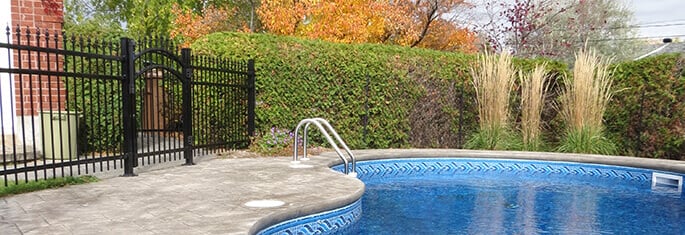So Long Pool Season, Until Next Year!

It’s already that time of year: Time to close our pools for the winter. Sure, it’s the same old fall routine – but do you really know to properly close your pool? If you’re not sure, the following steps and tips could save you a considerable amount of time, money and energy. They’ll also help to prolong the life of your pool. Not only that, but they’ll make opening your pool in the spring much easier, which means you’ll be able to start enjoying it as soon as those first warm days arrive!
Ready to become a pool closing pro? Then let’s dive right in!
• In the days leading up to closing your pool, take a water sample to your professional retailer and balance your water as per his or recommendations.
• On the day before closing, vacuum the pool and do a backwash. Then check the water’s pH and adjust it to 7.8. Next, clean the filter, the ring around the pool and the pool cover before storing them away for the winter. Always use products specifically designed for these tasks.
• On the day of closing, drain the pool first**. Lower the water level to below the skimmer and the return jets, and stop the pump.
**For pools with main drain function only, turn the three-way valve lever to close the skimmer, allowing the main drain to remain open. Stop the pump. If the filter has been cleaned, turn the filter lever to the “drain” position. If it hasn’t, turn it to the “backwash” position and let the pump run for 5 minutes. Shut the pump off again, and turn the lever to the “drain” position.
Pools without a bottom drain will have to be drained using the vacuum or a submersible pump.
• Store the pump: Unplug it, shut off the pump’s breaker and disconnect all of the hoses. Drain the water and, if necessary, clean the pump basket. Store the pump in a heated location.
• Store the filter: Unscrew the pressure gauge, remove the sight glass (if any), remove the cap at the bottom of the tank and place it in a tilted position for a few days to let the tank drain completely. Store these pieces together (a good place is in the pump basket). Turn the filter lever to “winterize” or between 2 positions if there’s no “winterize” position.
• Winterize the bottom drain: Disconnect the bottom drain hose under the three-way valve. Fasten the drain to the pool’s edge, letting it stick out above the pool. Very slowly pour antifreeze into the hose. Insert the styrofoam roll. Affix it solidly with a rubber band, or fold it over.
• Winterize the skimmer: Remove the skimmer door by gently bending it; also remove the skimmer basket. Clean the skimmer and insert a styrofoam block.
• Winterize the water returns: Unscrew the rings that surround the water returns to remove the eye. Screw in the winterizing caps to prevent water loss.
• Next, use a closing kit, carefully following all instructions. A closing kit will help keep pool water clean during the winter.
• Install the winter cover and/or safety cover. Tip: If you have leafy trees near your pool, stretch a mesh over your winter cover before the leaves begin to fall. Once they have all fallen, you can easily pull the mesh and the leaves away.
• Shut off the water heater: Remove the two valves located behind the water heater and drain the water by tilting it backwards. Then tilt the water heater forward, add one bottle of pool antifreeze and put the valves back in place. Disconnect the pressure switch.
It may seem like a lot of steps, but keep in mind that it’s important to protect your investment. Pool owners often forget a few steps, which invariably leads to equipment damage.
Some of the most common errors made by pool owners?
• Forgetting to close the drain valve (resulting in a draining pool)
• Forgetting to add antifreeze (which can lead to burst pipes)
• Leaving the pump outside (which can cause premature wear)
And don’t forget to enjoy the beautiful fall weather
Like what you’re reading?
Get practical, expert-driven advice—sent straight to your inbox


